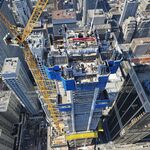11th
Senior Member
This works well for jurisdictions that do not allow turns on red.Since moving to the Netherlands, I have been examining how Dutch traffic signals manage to be so much more flexible and safe than Canadian ones, and I think a key factor is the widespread use of multi-stage crossings. And unlike the examples you might know in the GTA (University Ave, Highway 7, etc), the multi-stage crossings in the Netherlands still allow pedestrians to cross the street in one go.
I made a video to illustrate my thoughts:
A more basic set up would be 4 phases of advance green, with pedestrians getting the walk phases on crosswalks that do not conflict with moving traffic.
That means, if you get a walk signal, no traffic will be in your way. Vice versa for vehicles getting a green light.
Benefits of this setup also include shorter countdown time and elimination of dedicated turning lanes.




